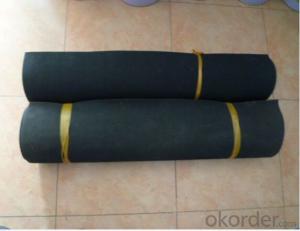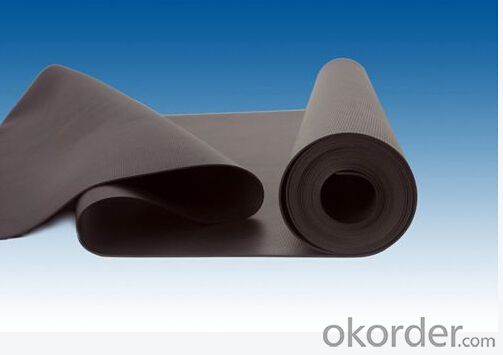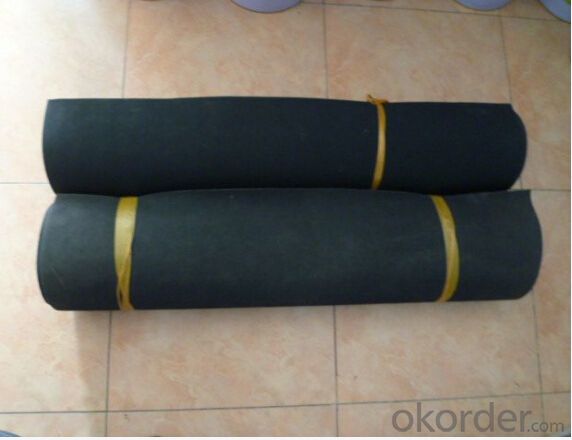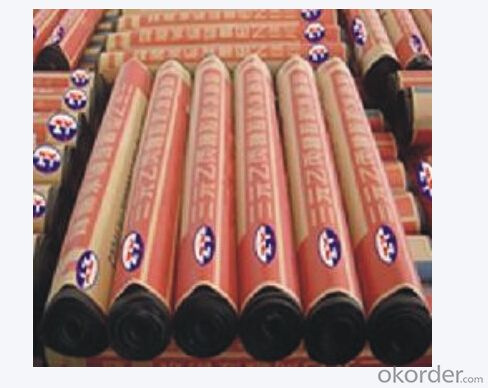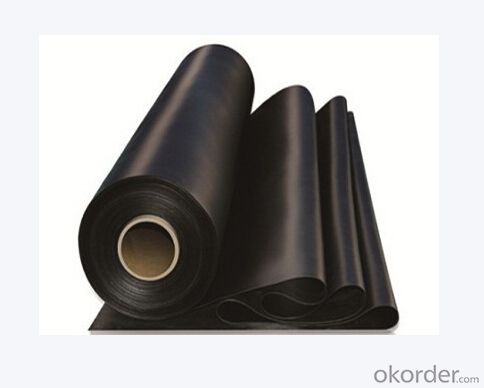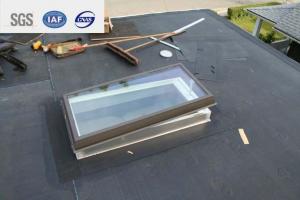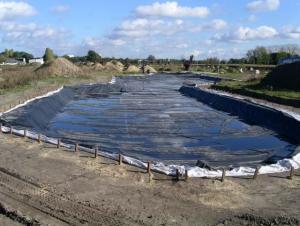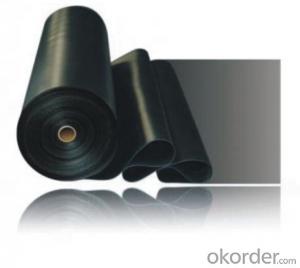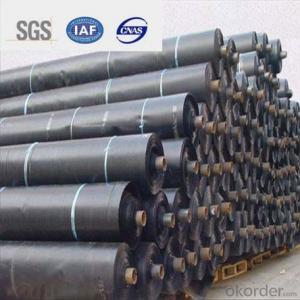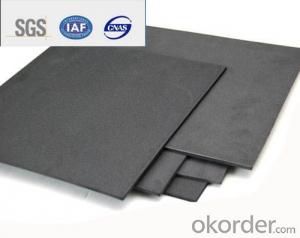EPDM Waterproofing Membrane Width 1.2m to 4m Used for Roof/Pond Liner/Basement
- Loading Port:
- Qingdao
- Payment Terms:
- TT or LC
- Min Order Qty:
- 2000 m²
- Supply Capability:
- 200000 m²/month
OKorder Service Pledge
OKorder Financial Service
You Might Also Like
EPDM waterproofing Membrane
1. Main Introudction:
EPDM Waterproofing Memebrane has high elasticity with best performance among high polumer waterproof coiled material in the world.
It is also the most typical one in the world.
Waterproof coiled material made of ternary ethylene propylene rubber is produced with the use of the most advanced contiuous extrusion and vulcanization technology and related equipments which are specially designed for production of such product.It is good in compactness,
without bubble and performance difference in length and breadth,perfomances reach or exceed the demands of GB18173.1-2000 standard.
2. Main Features:
1>Excellent antiaging performance, service life up to 50 years
2>Working well with in 40C to 100C,it canbe constructed with a single layer in ambient temperature.
3>Waterproofing on various kinds of underground project,industrial of civil buildings and structures.
4>high extension rate, high tensile strength, small size changes at heat treatment
5>Good plant roots penetrability resistance and can be made waterproofing layer of planting roof
6>Special modified molecular structure ,effectively resolving the current domestic and foreign glue joint problem .
7>Good low temperature flexibility, and good performance of adapting to ambient temperature changes.
8>Convenient application ,solid joint, no environment pollution
9>chemical corrosion Resistance, can be used for special occasions
10>Convenient maitenance, low cost.
3. Main Application:
Widely used in roofs, basement, toilet ,swimming pool, and all kinds of industry and civil building
waterproofing, reservoir, vivicism, bridge, underground, tunnel and dam waterproofing ,especially
to the keystone waterproofing projects which is durability, high corrosion resistance and easy
deformation
4. Specification:
Type | EPDM Waterproof Membrane | |||
Material | EPDM Rubber | |||
Thickness | 1.0mm | 1.2mm | 1.5mm | 2.0mm |
Size | 1.2m(width) * 20m(length)/roll | |||
Type | Vulcanized | |||
Pattern | Non-reinforced(homogeneous) | |||
Packing | 24sqm--80sqm/roll, with plastic bag | |||
Color | Black | |||
Application | Roofs, basement, pond, Lake, steel structure roof, swimming pool, underground, tunnel, etc | |||
5. Some photos:
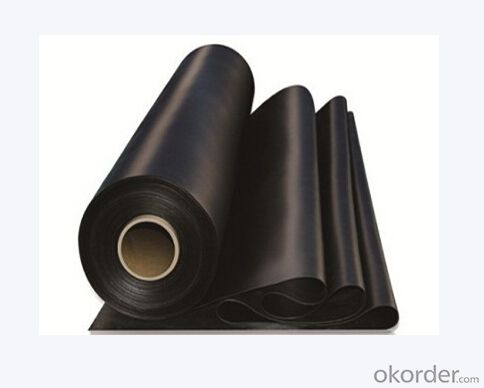
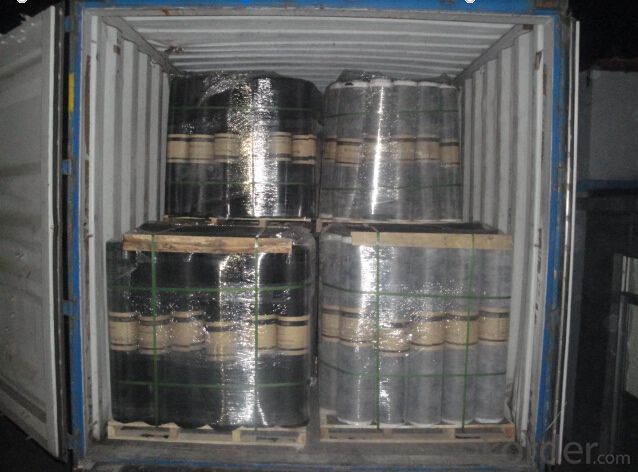
6. RFQ:
What's your payment terms?
T/T or L/C at sight is accepted
What's your package?
One roll with one woven bag, and several rolls in one pallet
What's your delivery time?
Within one week after deposit received
- Q: Is a waterproofing membrane resistant to hydrocarbons or oils?
- Yes, a waterproofing membrane is typically resistant to hydrocarbons or oils.
- Q: Is a waterproofing membrane resistant to cracking or shrinking?
- Yes, a waterproofing membrane is designed to be resistant to cracking and shrinking, providing a durable and long-lasting solution for preventing water penetration.
- Q: Can a waterproofing membrane be used on roofs with slope?
- Yes, a waterproofing membrane can be used on roofs with slope. In fact, it is often recommended to use a waterproofing membrane on sloped roofs to prevent water infiltration and to ensure proper drainage. The membrane is installed beneath the roofing material and acts as a barrier against moisture, helping to protect the roof and the underlying structure from water damage.
- Q: Can waterproofing membranes be used on balconies?
- Yes, waterproofing membranes can be used on balconies. These membranes are designed to provide a protective barrier against moisture, preventing water leaks and damage to the balcony structure. Waterproofing membranes are commonly used in balcony construction and renovation projects to ensure long-lasting water resistance and durability.
- Q: Are waterproofing membranes resistant to hydraulic oils?
- No, waterproofing membranes are not typically resistant to hydraulic oils.
- Q: Can a waterproofing membrane be used for bridge or tunnel waterproofing?
- Yes, a waterproofing membrane can be used for bridge or tunnel waterproofing. Waterproofing membranes are designed to create a barrier against water infiltration and are commonly used in various construction applications, including bridges and tunnels. These membranes are typically made of materials such as bitumen, PVC, or EPDM, which provide excellent resistance to water penetration. Bridge and tunnel structures are exposed to harsh environmental conditions, including water seepage, which can lead to corrosion and structural damage over time. By applying a waterproofing membrane to the surface of the bridge or tunnel, it helps to prevent water from entering the structure, protecting it against deterioration and extending its lifespan. Waterproofing membranes for bridges and tunnels are specifically engineered to withstand heavy traffic loads, weathering, and other environmental factors. They are designed to be durable, flexible, and resistant to cracking, ensuring long-term protection. These membranes are also typically UV resistant, which helps to maintain their integrity even when exposed to sunlight. Furthermore, waterproofing membranes can be installed in various ways, depending on the specific requirements of the bridge or tunnel project. They can be applied as liquid coatings, sprayed or rolled on, or installed as prefabricated sheets. This versatility allows for customization and efficient installation to suit the unique characteristics of each structure. In conclusion, a waterproofing membrane is a viable and effective solution for bridge and tunnel waterproofing. It provides a reliable barrier against water infiltration, protecting the structure from corrosion and deterioration, and extending its lifespan.
- Q: Does a waterproofing membrane require a protective layer?
- A protective layer is necessary for a waterproofing membrane. It has various functions. Firstly, it prevents damage to the membrane during and after installation by acting as a barrier against sharp objects, construction debris, and potential punctures. Additionally, the protective layer distributes loads evenly and provides stability to the membrane, reducing the risk of damage from foot traffic or heavy equipment. Moreover, the protective layer acts as a shield against UV rays, which can degrade the membrane over time and cause reduced effectiveness and potential leaks. It also helps regulate temperature fluctuations that can stress the membrane and compromise its waterproofing capabilities. To summarize, a protective layer is crucial for the durability and performance of a waterproofing membrane. It safeguards against physical damage, UV radiation, and temperature fluctuations, ensuring the membrane effectively keeps water out and maintains the integrity of the protected structure.
- Q: Can waterproofing membranes be used on concrete floors?
- Yes, waterproofing membranes can be used on concrete floors. They are commonly used to protect concrete surfaces from water damage and can be applied to both new and existing concrete floors to prevent water penetration and moisture-related issues such as mold, mildew, and deterioration.
- Q: Does a waterproofing membrane require any specific surface preparation?
- Yes, a waterproofing membrane typically requires specific surface preparation before installation. This involves cleaning the surface, removing any loose debris, and ensuring it is smooth and dry. Additionally, some membranes may require priming or the use of specific adhesives depending on the type of surface they are being applied to. Proper surface preparation is crucial to ensure effective adhesion and long-lasting waterproofing performance.
- Q: What is the best waterproofing membrane for my project?
- The best waterproofing membrane for your project depends on various factors such as the type of project, the specific requirements, and the budget. There are several options available in the market, each offering different features and benefits. One popular choice is a bituminous waterproofing membrane. It is a cost-effective option suitable for a wide range of projects, including roofs, basements, and foundations. Bituminous membranes are durable, flexible, and capable of withstanding extreme weather conditions. They can be applied using torch-on, self-adhesive, or hot-melt methods. Another option to consider is a polyurethane liquid membrane. This type of membrane provides excellent elasticity, making it ideal for areas that require flexibility, such as balconies, terraces, and swimming pools. Polyurethane membranes are resistant to UV rays and can be easily applied by brush or roller. For projects that require a high level of durability and resistance, a cementitious waterproofing membrane might be the best choice. It is a mixture of cement, sand, and special additives that create a thick, protective layer. Cementitious membranes are commonly used for underground structures, tunnels, and water tanks. If your project involves below-grade applications or areas with high water pressure, a bentonite waterproofing membrane could be the best option. Bentonite membranes are made of clay minerals that swell when exposed to water, forming a watertight barrier. They are commonly used in basements, foundations, and retaining walls. Ultimately, the best waterproofing membrane for your project will depend on the specific requirements, budget, and preferences. It is recommended to consult with a professional waterproofing contractor who can assess your project's needs and recommend the most suitable membrane system.
Send your message to us
EPDM Waterproofing Membrane Width 1.2m to 4m Used for Roof/Pond Liner/Basement
- Loading Port:
- Qingdao
- Payment Terms:
- TT or LC
- Min Order Qty:
- 2000 m²
- Supply Capability:
- 200000 m²/month
OKorder Service Pledge
OKorder Financial Service
Similar products
Hot products
Hot Searches
Related keywords


